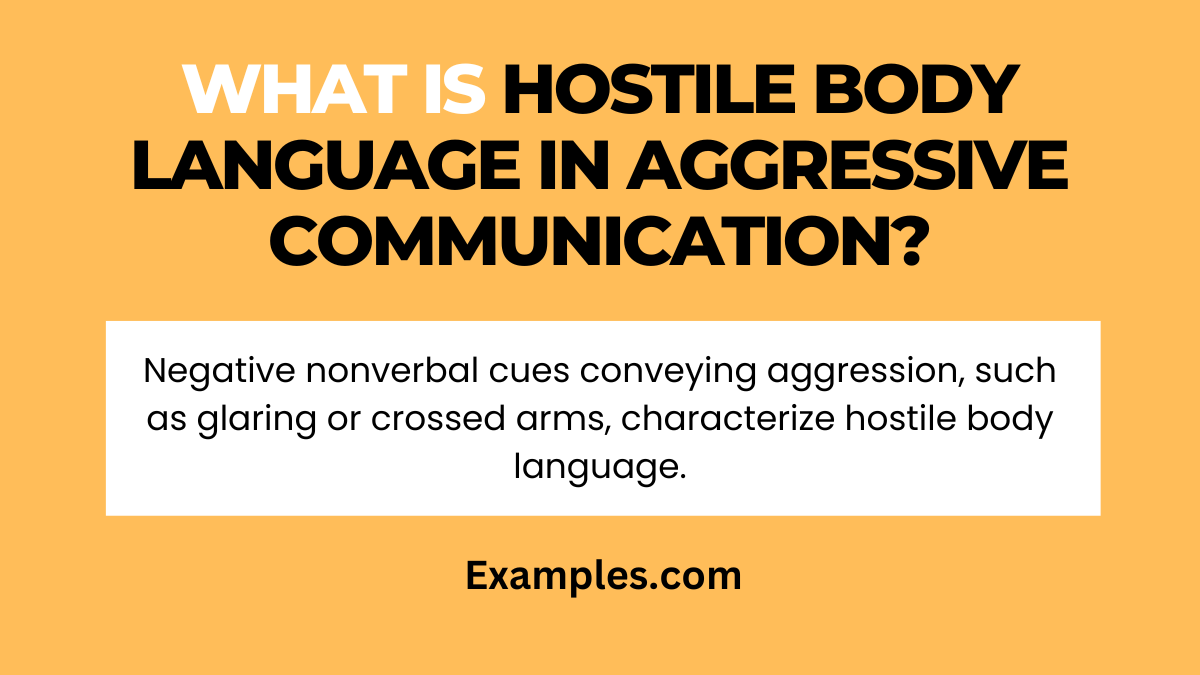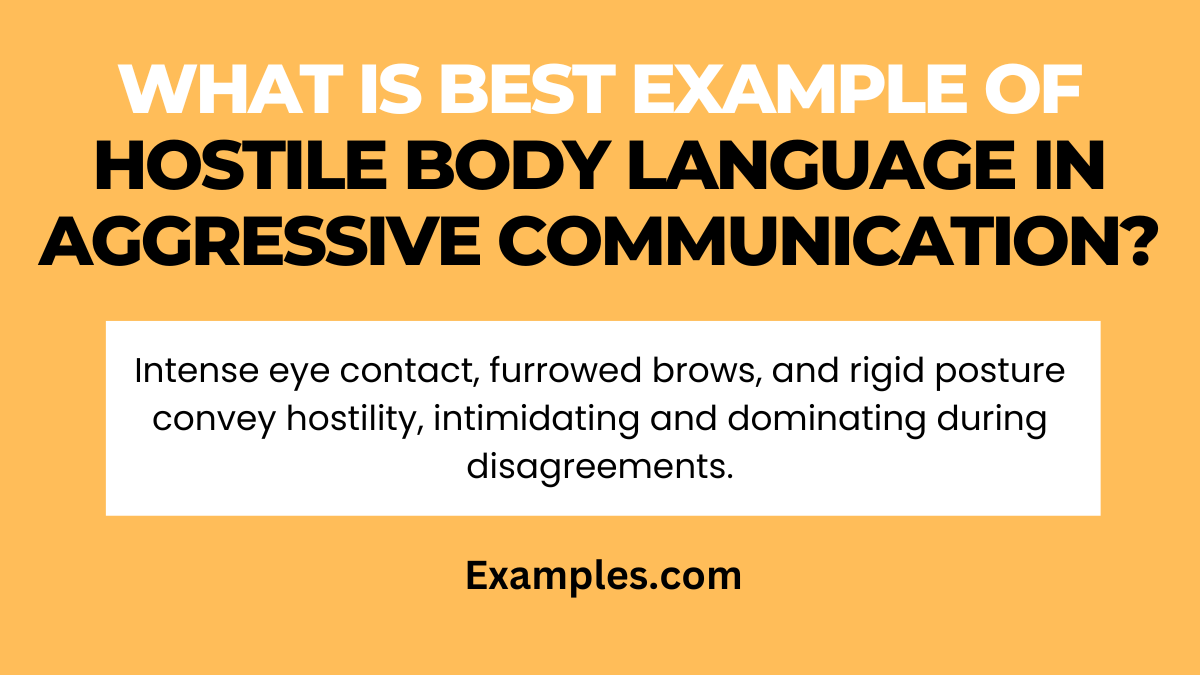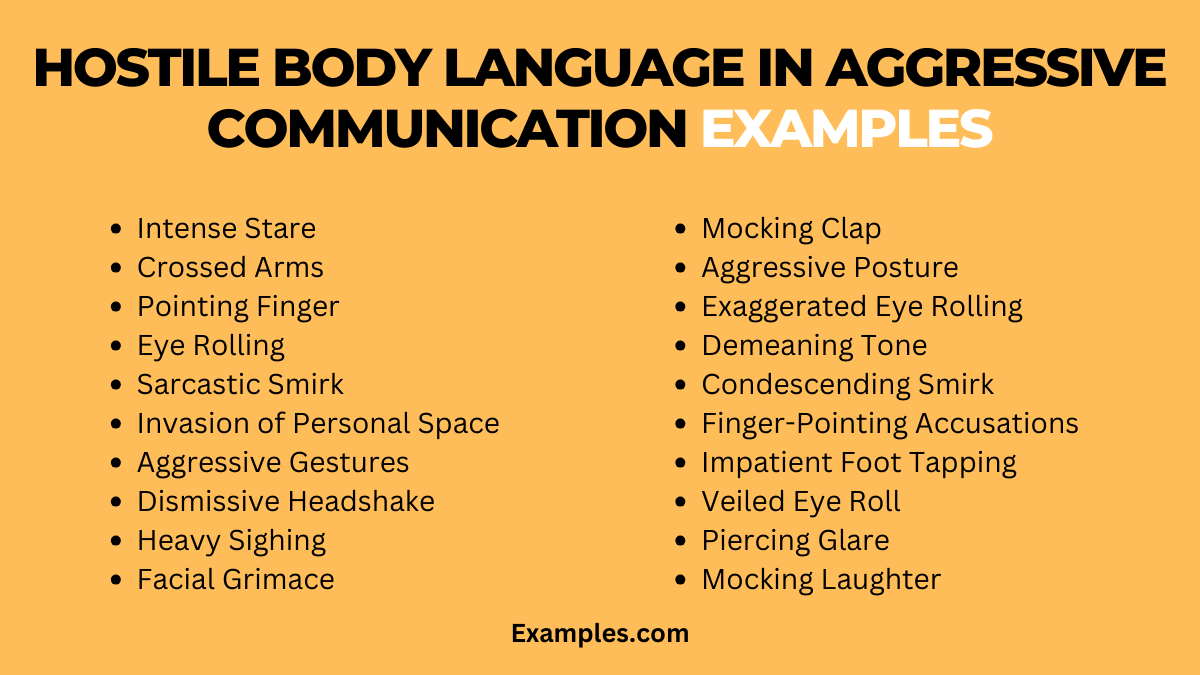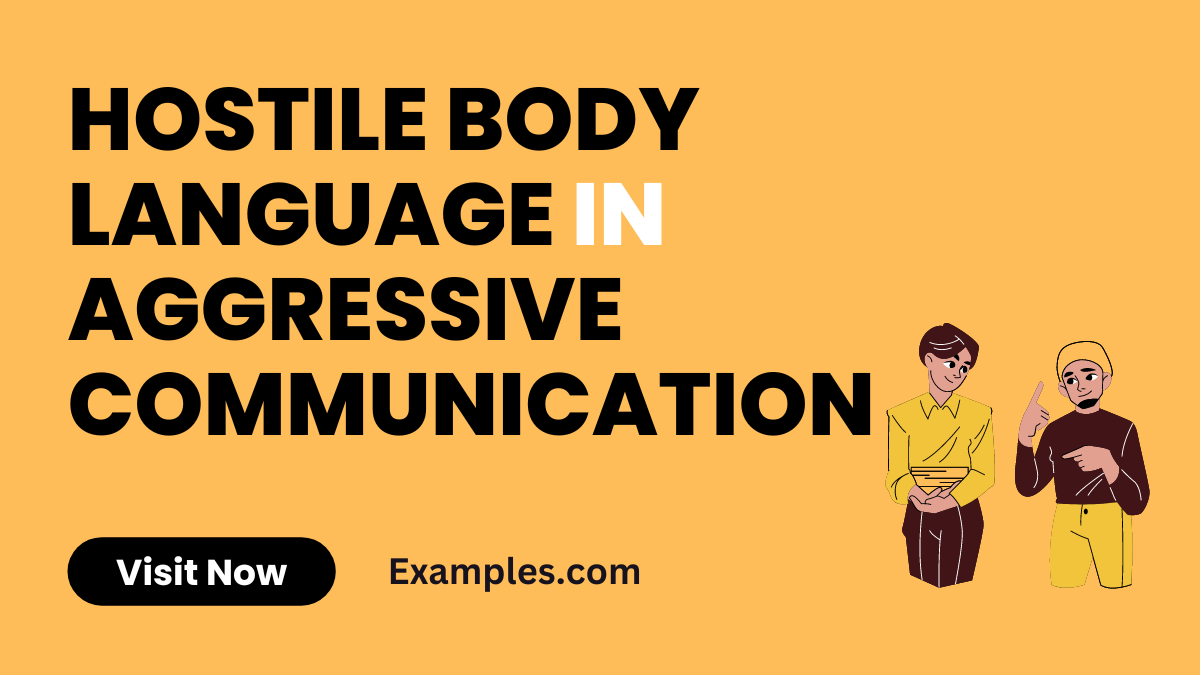19+ Hostile Body Language in Aggressive Communication Examples
Unravel the intricacies of Hostile Body Language in Aggressive Communication with our comprehensive guide. Delve into real-life scenarios and expert insights to understand the nuanced impact of nonverbal cues. Master the art of impactful communication by exploring vivid Communication Examples that decode the power of hostile body language, providing you with essential tools to navigate assertiveness effectively. Elevate your understanding and communication prowess in any situation.
What is Hostile Body Language in Aggressive Communication?

Hostile body language in aggressive communication refers to nonverbal cues that convey antagonism, disdain, or dominance. Actions such as glaring, crossed arms, or dismissive gestures amplify verbal aggression. This body language intensifies the impact of aggressive communication styles, reinforcing a confrontational tone. Understanding these nonverbal signals is crucial for decoding the underlying emotions and navigating assertive interactions effectively.
What is the Best Example of Hostile Body Language in Aggressive Communication?

One illustrative example involves intense eye contact, furrowed brows, and a rigid posture during a disagreement. In this scenario, the individual deploys hostile body language to intimidate and assert dominance. The glaring eyes and tense demeanor contribute to an atmosphere of hostility, reinforcing the aggressive verbal exchange. Understanding such examples is pivotal for recognizing and addressing the impact of nonverbal cues in aggressive communication dynamics.
20 Hostile Body Language in Aggressive Communication Examples

Hostile body language in aggressive communication is expressed through nonverbal cues that convey anger, dominance, and confrontation. These subtle yet powerful gestures intensify verbal aggression, shaping the overall communication dynamic negatively. Understanding these examples is crucial for fostering healthier interactions.
- Intense Stare: During a disagreement, John fixed his gaze on Sarah, creating an intimidating atmosphere. His intense stare heightened the aggressiveness of their interaction.
- Crossed Arms: Mary crossed her arms tightly, signaling defensiveness and defiance, amplifying the aggressive tone in her communication.
- Pointing Finger: Alex pointed accusatory fingers while expressing frustration, contributing to an aggressive communication style by emphasizing blame.
- Eye Rolling: In response to criticism, Lisa rolled her eyes dismissively, conveying contempt and further escalating the aggressive tone of the conversation.
- Sarcastic Smirk: Mark responded with a sarcastic smirk, using facial expressions to belittle others and augment the aggressive nature of his communication.
- Invasion of Personal Space: Sarah deliberately invaded Tom’s personal space, amplifying the tension and aggression in their interaction through physical intimidation.
- Aggressive Gestures: Jake accompanied his verbal aggression with aggressive gestures, such as clenched fists, adding a threatening layer to the communication.
- Dismissive Headshake: During a team meeting, Emma shook her head dismissively, displaying nonverbal disapproval and contributing to an adversarial communication atmosphere.
- Heavy Sighing: Linda punctuated her statements with heavy sighs, conveying frustration and impatience, intensifying the aggressive undertones in her communication.
- Facial Grimace: Daniel’s facial grimace of disgust accentuated his disapproval, fostering a hostile communication environment during the discussion.
- Mocking Clap: Paul concluded his argument with a mocking clap, using applause to deride others and underscore the aggressive nature of his communication.
- Aggressive Posture: During negotiations, Sandra adopted an aggressive posture, standing tall and leaning forward to establish dominance and convey confrontation.
- Exaggerated Eye Rolling: Michelle accompanied her disdainful remarks with exaggerated eye rolling, intensifying the perceived arrogance and aggression in her communication.
- Demeaning Tone: Greg’s communication took an aggressive turn with a demeaning tone, contributing to a hostile environment by undermining others.
- Condescending Smirk: Carol responded with a condescending smirk, using facial expressions to belittle others and escalate the aggression in the conversation.
- Finger-Pointing Accusations: Steve punctuated his accusations with finger-pointing, visually emphasizing blame and augmenting the overall aggressiveness of the exchange.
- Impatient Foot Tapping: Samantha’s impatient foot tapping during a discussion added a layer of nonverbal aggression, signaling annoyance and escalating tension.
- Veiled Eye Roll: James subtly expressed disagreement with a veiled eye roll, introducing passive-aggressive hostility into the communication.
- Piercing Glare: During a confrontation, Emily fixed a piercing glare on her colleague, intensifying the hostile atmosphere with a nonverbal display of anger.
- Mocking Laughter: Alex responded to criticism with mocking laughter, using nonverbal cues to dismiss others and heighten the aggressive undertones in the communication.
Hostile Body Language in Aggressive Communication Examples for Couples
Navigating conflicts in relationships requires awareness of hostile body language. Unspoken cues can escalate tensions.
- Silent Treatment: In a disagreement, Jack gave Sara the silent treatment, a non-verbal signal of displeasure that intensified the emotional rift.
- Eye Rolling Dynamics: During a discussion, Lisa and Mark engaged in reciprocal eye rolling, showcasing mutual disdain and heightening the aggression.
- Intimate Space Invasion: John invaded Rachel’s personal space during an argument, adding a physical dimension to the hostility within their communication.
- Closed-off Posture: Sarah adopted a closed-off posture, crossing arms and legs, signaling defensiveness and escalating tension in the conversation.
- Sarcastic Gestures: Mike’s use of sarcastic gestures while discussing sensitive issues with Maria intensified the hostility in their communication dynamics.
Hostile Body Language in Aggressive Communication Examples at Work
In a professional setting, recognizing hostile body language is crucial for maintaining a healthy work environment.
- Dismissive Headshake: During a meeting, Emma’s dismissive headshake conveyed disagreement, contributing to a hostile communication atmosphere in the workplace.
- Aggressive Posture in Negotiations: Sandra adopted an aggressive posture during negotiations, signaling dominance and contributing to an adversarial work environment.
- Impatient Foot Tapping: Samantha’s impatient foot tapping during discussions added nonverbal aggression, signaling annoyance and escalating tension in the workplace.
- Veiled Eye Roll in Team Discussions: James subtly expressed disagreement with a veiled eye roll during team discussions, introducing passive-aggressive hostility to the workplace communication.
- Hostile Body Language in Performance Review: During a performance review, Alex displayed hostile body language, such as crossed arms and a scowling expression, creating a tense work environment.
How does Hostile Body Language Manifest in Aggressive Communication?
Hostile body language is a powerful nonverbal aspect of aggressive communication, reflecting underlying tensions and intensifying conflicts. Recognizing its manifestations is crucial for effective conflict resolution.
- Silent Signals of Displeasure: Individuals may employ the silent treatment, avoiding eye contact or communication, conveying strong negative emotions without uttering a word.
- Non-Verbal Aggression: Aggressive postures, gestures, and facial expressions serve as non-verbal tools, communicating hostility and escalating confrontations.
- Intimate Space Invasion: Invading personal space aggressively during conversations signifies a disregard for boundaries, intensifying the aggressive communication dynamic.
- Facial Expressions and Eye Movements: Negative facial expressions, eye rolling, and disdainful glares contribute to a hostile atmosphere, creating tension in verbal exchanges.
- Defensive Body Language: Individuals adopt defensive postures, such as crossed arms and closed-off stances, signaling resistance and escalating aggression.
In What Ways Can Individuals Recognize and Interpret Hostile Body Language in Aggressive Communication?
Interpreting hostile body language is essential for effective communication. Understanding subtle cues enables individuals to address conflicts and maintain healthier relationships.
- Observing Facial Microexpressions: Microexpressions such as frowns, narrowed eyes, or clenched jaws reveal underlying emotions, offering insights into the aggressive nature of communication.
- Deciphering Non-Verbal Cues: Recognition of aggressive postures, gestures, and eye movements aids in deciphering unspoken messages, providing clarity in communication dynamics.
- Analyzing Tone and Volume: Hostile body language often accompanies changes in vocal tone and volume. Recognizing these variations helps in understanding the aggressive context.
- Considering Contextual Cues: Understanding the broader context of communication is vital. Hostile body language may differ in meaning based on the situation and relationships involved.
- Addressing Subtle Changes: Subtle shifts in body language, such as increased tension or stiffness, can signal brewing hostility, prompting proactive measures to address the issue.
What Role Does Hostile Body Language Play in Shaping Aggressive Communication Styles?
Hostile body language serves as a catalyst in shaping aggressive communication styles, amplifying verbal conflicts and influencing overall communication dynamics.
- Reinforcing Dominance: Aggressive postures and gestures reinforce dominance, contributing to a communication style characterized by control and assertiveness.
- Intensifying Emotional Expression: Facial expressions and non-verbal cues intensify emotional expression, shaping aggressive communication styles marked by heightened emotional tension.
- Escalating Verbal Confrontations: Hostile body language contributes to the escalation of verbal confrontations, creating a cycle of aggression within communication styles.
- Fueling Defensive Responses: Defensive body language triggers defensive responses, fostering a communication style where individuals react to perceived threats with aggression.
- Impacting Workplace Atmosphere: In professional settings, hostile body language shapes the workplace atmosphere, influencing communication styles and contributing to a tense work environment.
In conclusion, understanding and addressing hostile body language are paramount for effective communication and conflict resolution. Recognizing subtle cues and interpreting non-verbal expressions empower individuals to navigate aggressive communication dynamics. By acknowledging the role of hostile body language in shaping communication styles, one can work towards fostering healthier interactions and maintaining positive relationships.



